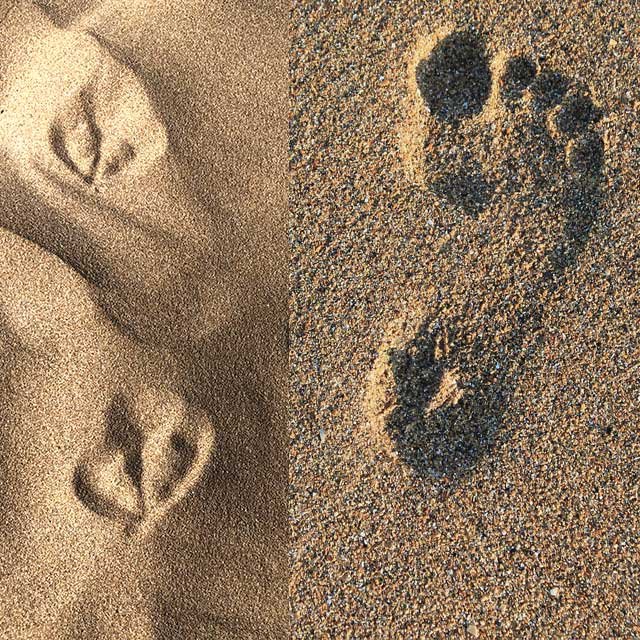Loading...
TOOLKIT

Making connections with animals footprints (expression)
LOCATIVE MEDIA SUPERCLUSTER
Improving our connections with people by cultivating a sense of belonging to Nature by Fred Adam & Geert Vermeire
This set of practices is meant to improve our connection with people by opening our senses and feeling the beauty of Nature. But it is also about acknowledging the intelligence of the more than human world, listening to the polyphony of languages, interactions and connections going on around us and with us. We belong to the natural world and we are part of it. Intelligence is not only ours, it is the result of millions of years of evolution. Our ability to develop a greater intimacy with nature is a powerful way to expand our sense of belonging, a shared identity and our love for people because we are all Nature.

DURATION
30 minutes
This exercise inspired by "making connections" from the Academia di Belle Arti di Napoli is meant to develop the skill of expression through the conscious creation of footprints in harmony with other footprints. Paleolithic artists usually represented wild animals living in their area. We can also find numerous shapes of hands on the at least more than 36.000 years old rock wall paintings like the Chauvet cave in France or the Altamira cave in Spain. These paintings celebrate the deep connections between humans and the animals sharing the same habitat. Today even if we do not imprint our hands anymore on the rock with natural pigment, we imprint our steps on the floor everywhere we go. But it is also a great variety of birds and mammals beyond others who leave their mark on the ground. It is especially easy to discover this great quantity while walking on the sand along the sea shore. This is the ancient art of tracking, the ability to notice and identify footprints. This exercise is intended to wake up our ability to notice and identify beings who crossed our path in time and unlock a secret message. Footprints are like words in a book we can read and following the tracks can become an act of poetry. But you can also start to write your own words in a conscious way and in harmony with Nature.
Step 1: Find a place where you can see footprints, in the sand or in the mud in a forest for example. You can ask yourself the 6 questions about these tracks: what who how when where why.
Step 2: Let's investigate the "where" for the moment and try to follow the tracks. Imagine the weight of the animal, "who" revealed by the depth and the shape of the footprint. Be careful not to walk on top of these tracks.
Step 3: Now that you have spotted a trajectory, it is your time to add your tracks and take of your shoes if it is possible. Feel the Earth soil as a giant canvas where an infinity of beings are drawing-writing words and sentences with their body in motion. Start to draw with your feet in harmony with the other being footprints as if it was a musical score where you will add your own instrument.
Step 4: The person coordinating the activity will use a watch or a bell to set up a 15 min alarm and clarify that the participants will be informed when the time of the practice is over.
Step 5: The person coordinating the activity will invite people to sit in a circle during 15 minutes and comment on what they experienced. Establish a conversation regarding the connections between our body's footprint and our global ecological footprint.
Step 6: The person coordinating the activity will propose to download and walk the free mobile app Deep Time Walk. It is a walking story created by Schumacher College in collaboration with Supercluster. It is an audio walk of the story of the evolution of life on Earth where each step we take is one million years.
- Deep Time Walk app, discover when the first sounds of living beings appeared on the planet (deeptimewalk.org
Important notice
We have to be conscious that leaving footprints can have a negative impact on the environment, it can damage and disturb. As a painter painting on canvas every detail of the landscape, being aware of our footprints is helpful to explore ways to be in harmony with the natural world and with yourself because we are also nature.
evaluation: This transformative experience should provoke in the participants a sense of appreciation for the soil, being aware that every footprints are meaningful. It can trigger the interest to learn the art of tracking wild animals.
references: This practice is inspired by great teachers, Nature of course but also Rich Blundell and the Oika project, Jon Young from the 8 shields and the partners from the project No One Forgotten beyond others. Thank you!
what you can do before or after this exercise

Opening hours
Monday to Friday: 8:00 am - 6:00 pm
Saturday: 8:00 am - 2:00 pm
Sunday: Closed


